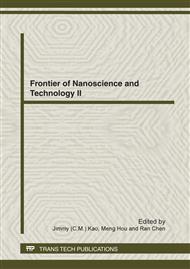[1]
A. Georg, A. Georg, Electrochromic device with a redox electrolyte, Sol. Energy Mater. Sol. Cells. 93 (2009) 1329–1337.
DOI: 10.1016/j.solmat.2009.02.009
Google Scholar
[2]
P. R. Somani, S. Radhakrishnan, Electrochromic materials and devices: present and future, Mater. Chem. Phys. 77 (2002) 117–133.
Google Scholar
[3]
K.J. Patel, C.J. Panchal, M.S. Desai, P.K. Mehta, An investigation of the insertion of the cations H+, Na+, K+ on the electrochromic properties of the thermally evaporated WO3 thin films grown at different substrate temperatures, Mater. Chem. Phys. 124 (2010).
DOI: 10.1016/j.matchemphys.2010.08.021
Google Scholar
[4]
X. Sun, Z. Liu, H. o Cao, Effects of film density on electrochromic tungsten oxide thin films deposited by reactive dc-pulsed magnetron sputtering, J. Alloys Compd. 504S (2010) S418–S421.
DOI: 10.1016/j.jallcom.2010.03.155
Google Scholar
[5]
C. M. White, D. T. Gillaspie, E. Whitney, S. Hee Lee, Anne C. Dillon, Flexible electrochromic devices based on crystalline WO3 nanostructures produced with hot-wire chemical vapor deposition, Thin Solid Films. 12 (2009) 3596–3599.
DOI: 10.1016/j.tsf.2009.01.033
Google Scholar
[6]
A.A. Joraid, Comparison of electrochromic amorphous and crystalline electron beam deposited WO3 thin films, Curr. Appl Phys. 9 (2009) 73–79.
DOI: 10.1016/j.cap.2007.11.012
Google Scholar
[7]
J.M. Ortega, A. I. Martı´nez, D. R. Acosta, C. R. Magan˜ a, Structural and electrochemical studies of WO3 films deposited by pulsed spray pyrolysis, Sol. Energy Mater. Sol. Cells. 90 (2006) 2471–2479.
DOI: 10.1016/j.solmat.2006.03.033
Google Scholar
[8]
M. Deepa, T.K. Saxena, D.P. Singh, K.N. Sood, S.A. Agnihotry, Spin coated versus dip coated electrochromic tungsten oxide films: Structure, morphology, optical and electrochemical properties, Electrochim. Acta. 51(2006) 1974-(1989).
DOI: 10.1016/j.electacta.2005.06.027
Google Scholar
[9]
S. R Bathe, P. S Patil, Influence of Nb doping on the electrochromic properties of WO3 films, J. Phys. D : Appl. Phys. 40(2007) 7423-7431.
DOI: 10.1088/0022-3727/40/23/025
Google Scholar
[10]
J.M. O-Rueda de León, D.R. Acosta, Improving electrochromic behavior spray pyrolised WO3 thin solid films Mo doping, Electrochim. Acta. 56(2011) 2599-2605.
DOI: 10.1016/j.electacta.2010.11.038
Google Scholar
[11]
K. Paipitak, C. Kahattha, W. Techitdheera, S. Porntheeraphat, W. Pecharapa, Characterization of Sol-gel Derived Ti-doped Tungsten Oxide Electrochromic Thin Films, Energy Procedia. 9(2011) 446-451.
DOI: 10.1016/j.egypro.2011.09.050
Google Scholar
[12]
S. Wu, F. Li, H. Wang, L. Fu, B. Zhang, G. Li, Effects of poly (vinyl alcohol) (PVA) content on preparation of novel thiol-functionalized mesoporous PVA/SiO2 composite nanofiber membranes and their application for adsorption of heavy metal ions from aqueous solution, Polymer. 51 (2010).
DOI: 10.1016/j.polymer.2010.10.015
Google Scholar
[13]
X. Wang, K. Zhang, Y. Yang, L. Wang, Z. Zhou, M. Zhu, B. S. Hsiao, B. Chu, Development of hydrophilic barrier layer on nanofibrous substrate as composite membrane via a facile route, J. Membr. Sci. 356 (2010) 110–116.
DOI: 10.1016/j.memsci.2010.03.039
Google Scholar
[14]
F, Jiang, T. Zheng, Y. Yang, Preparation and electrochromic properties of tungsten oxide and iridium oxide porous films, J. Non-Cryst. Solids. 354 (2008) 1290–1293.
DOI: 10.1016/j.jnoncrysol.2006.10.083
Google Scholar
[15]
V. Vinay Shankar, H. Martin, S. Alan, S. Kirill, K. Dennis, B. Radim, S. Wolfgang, L. Alfred, Enhanced photoelectrochemical properties of WO3 thin films fabricated by reactive magnetron sputtering, Int. J. Hydrogen Energy. 36 (2011): 4724-4731.
DOI: 10.1016/j.ijhydene.2011.01.087
Google Scholar
[16]
H. Chi-Hwan, H. Sang-Do, G. Jihye, S.P. Khatkar, Synthesis of indium tin oxide (ITO) and fluorine-doped tin oxide (FTO) nano - powder by sol–gel combustion hybrid method, Mater. Lett. 61 (2007): 1701–1703.
DOI: 10.1016/j.matlet.2006.07.114
Google Scholar
[17]
M. Deepa, A.K. Srivastava, S.N. Sharma, G., S.M. Shivaprasad, Microstructural and electrochromic properties of tungsten oxide thin films produced by surfactant mediated electrodeposition, Appl. Surf. Sci. 254 (2008) 2342-2352.
DOI: 10.1016/j.apsusc.2007.09.035
Google Scholar
[18]
M. Giannouli, G. Leftheriotis, The effect of precursor aging on the morphology and electrochromic performance of electrodeposited tungsten oxide films, Sol. Energy Mater. Sol. Cells. 95 (2011) 1932–(1939).
DOI: 10.1016/j.solmat.2011.02.024
Google Scholar
[19]
M. Deepa, A.K. Srivastava, S.N. Sharma, S.M. Shivaprasad, Microstructural and electrochromic properties of tungsten oxide thin films produced by surfactant mediated electrodeposition, Appl. Surf. Sci. 254(2008).
DOI: 10.1016/j.apsusc.2007.09.035
Google Scholar


